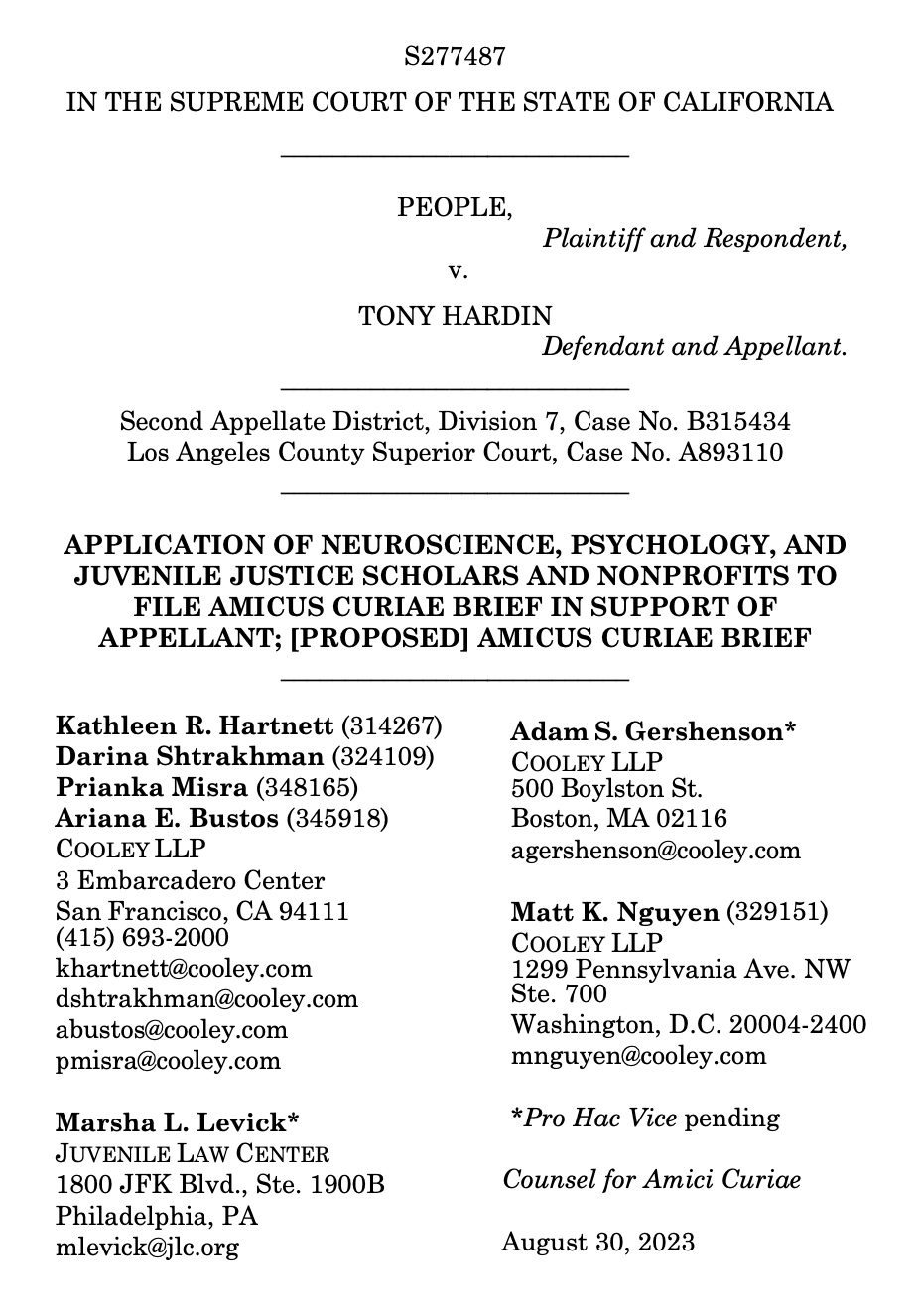
Summary of Argument
Under well-established California law, anyone sentenced to life without the possibility of parole (LWOP) for any offenses committed before their 18th birthday must eventually receive a parole hearing. That constitutional and statutory directive arose due to scientific findings that prompted courts to conclude that, irrespective of offense or issued sentence, the still-developing brains and personalities of adolescents under the age of 18 render them less culpable and more capable of reform. In recent years, a wealth of scientific research has confirmed that persons in “late adolescence”—ages 18-25—share these same mitigating traits. However, for late adolescents sentenced to LWOP, current state law overlooks their reduced culpability and enhanced prospects for reform by depriving them of any parole hearing at all.
As the Court of Appeal recognized, California’s current approach—depriving certain late adolescents of the chance to demonstrate reduced culpability and strong capacity for change— runs counter to the currently established yet continuously growing body of neuroscientific and psychological studies. Collectively, these studies conclusively prove that late adolescents, like persons in earlier phases of adolescence, and irrespective of offense or issued sentence, possess still-developing brains and personalities that render them less culpable and more capable of reform.
Pursuant to these findings, the Legislature expanded the definition of “youthful offender” to include all late adolescents. (Pen. Code, § 3051.)2 Section 3051 currently instructs the Board of Parole Hearings (the “Board”) to offer parole hearings for “youthful offenders” during which time the Board “shall give great weight to the diminished culpability of youth as compared to adults, the hallmark features of youth, and any subsequent growth and increased maturity.” (§ 4801, subd. (c).) At the same time, however, even as the Legislature redefined “youthful offender” to encompass all late adolescents, section 3051(h) excludes late adolescents sentenced to LWOP from this ameliorative program.
In amending section 3051’s “youthful offender” definition, the Legislature sought “to account for neuroscience research that the human brain—especially those portions responsible for judgment and decision-making—continues to develop” through late adolescence. (People v. Edwards (2019) 34 Cal.App.5th 183, 198.) “[R]elying on science,” the Legislature expressly “recognized that these mitigating attributes ‘are found in young adults up to age 25’ and ‘that the ordinary process of neurological and cognitive development continues for several years past age 18.’ ” (People v. Jackson (2021) 279 Cal.Rptr.3d 396, 406–07 (conc. stmt. of Liu, J.).) Thus, “the intent of the Legislature [was] to create a process by which growth and maturity of youthful offenders [including late adolescents] can be assessed and a meaningful opportunity for release established.” (§ 3051, as amended by Stats. 2013, ch. 312, § 1.)
As the Court of Appeal recognized, section 3051’s “intended purpose” is to “permit[] a determination whether a person who committed a serious or violent crime between the age of 18 and 25 has sufficiently matured and outgrown the youthful impulses that led to the commission of the offense.” (People v. Hardin (2002) 84 Cal.App.5th 273, 287.) In light of this intent, amici submit that the categorical exclusion of certain late adolescents from future parole hearings thwarts the Legislature’s express intent to align late adolescent parole eligibility with prevailing neuroscience and “to create a process by which [mitigating attributes] can be assessed and a meaningful opportunity for release established” for all “youthful offenders.” (§ 3051.)
Crucially, the Legislature’s failure to make parole hearings available to all late adolescents, regardless of offense or issued sentence, is irrational and unsupported by science. As detailed in this Brief, the developmental processes that make all late adolescents more vulnerable to risk-taking, negative peer influence, and criminality, as well as more receptive to lasting reform once mature, do not depend on their offense or sentence. (People v. Montelongo (2021), 274 Cal.Rptr.3d 267, 289 (conc. stmt. of Liu, J.) (Montelongo) [section 3051(h) stands in “tension” with “the high court’s clear statement that the mitigating attributes of youth are not ‘crime-specific’ [citation] and our Legislature’s recognition that those attributes are found in young adults up to age 25”].) From the perspective of brain science, then, late adolescents like Tony Hardin who received LWOP sentences are similarly situated to life term parole-eligible late adolescents and other late adolescents: none are beyond section 3051’s rehabilitative reach.
Given this, section 3051(h)’s line-drawing—allowing some late adolescents access to parole and denying others that same opportunity—relies on an unsound premise repudiated by science. The provision thwarts the Legislature’s overriding purpose in enacting and amending section 3051 to effectively codify the prevailing scientific consensus and guarantee parole eligibility for all “youthful offenders,” in light of the ongoing maturation and diminished culpability of late adolescents. Accordingly, amici submit that section 3051(h) is irrational.
The judgment of the Court of Appeal should be affirmed.